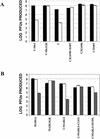Mutagenesis versus inhibition in the efficiency of extinction of foot-and-mouth disease virus
- PMID: 12768034
- PMCID: PMC156209
- DOI: 10.1128/jvi.77.12.7131-7138.2003
Mutagenesis versus inhibition in the efficiency of extinction of foot-and-mouth disease virus
Abstract
RNA viruses replicate near the error threshold for maintenance of genetic information, and an increase in mutation frequency during replication may drive RNA viruses to extinction in a process termed lethal mutagenesis. This report addresses the efficiency of extinction (versus escape from extinction) of foot-and-mouth disease virus (FMDV) by combinations of the mutagenic base analog 5-fluorouracil (FU) and the antiviral inhibitors guanidine hydrochloride (G) and heparin (H). Selection of G- or H-resistant, extinction-escape mutants occurred with low-fitness virus only in the absence of FU and with high-fitness virus with some mutagen-inhibitor combinations tested. The combination of FU, G, and H prevented selection of extinction-escape mutants in all cases examined, and extinction of high-fitness FMDV could not be achieved by equivalent inhibitory activity exerted by the nonmutagenic agents. The G-resistant phenotype was mapped in nonstructural protein 2C by introducing the relevant mutations in infectious cDNA clones. Decreases in FMDV infectivity were accompanied by modest decreases in the intracellular and extracellular levels of FMDV RNA, maximal intracellular concentrations of FU triphosphate, and a decrease in the intracellular concentrations of UTP. In addition to indicating a key participation of mutagenesis in virus extinction, the results suggest that picornaviruses provide versatile experimental systems to approach the problem of extinction failure associated with inhibitor-escape mutants during treatments based on enhanced mutagenesis.
Figures





Similar articles
-
Efficient virus extinction by combinations of a mutagen and antiviral inhibitors.J Virol. 2001 Oct;75(20):9723-30. doi: 10.1128/JVI.75.20.9723-9730.2001. J Virol. 2001. PMID: 11559805 Free PMC article.
-
Action of mutagenic agents and antiviral inhibitors on foot-and-mouth disease virus.Virus Res. 2005 Feb;107(2):183-93. doi: 10.1016/j.virusres.2004.11.008. Virus Res. 2005. PMID: 15649564 Review.
-
Potential benefits of sequential inhibitor-mutagen treatments of RNA virus infections.PLoS Pathog. 2009 Nov;5(11):e1000658. doi: 10.1371/journal.ppat.1000658. Epub 2009 Nov 13. PLoS Pathog. 2009. PMID: 19911056 Free PMC article.
-
Influence of mutagenesis and viral load on the sustained low-level replication of an RNA virus.J Mol Biol. 2011 Mar 18;407(1):60-78. doi: 10.1016/j.jmb.2011.01.026. Epub 2011 Jan 19. J Mol Biol. 2011. PMID: 21256131
-
Quasispecies dynamics and RNA virus extinction.Virus Res. 2005 Feb;107(2):129-39. doi: 10.1016/j.virusres.2004.11.003. Virus Res. 2005. PMID: 15649559 Review.
Cited by
-
Lethal Mutagenesis of RNA Viruses and Approved Drugs with Antiviral Mutagenic Activity.Viruses. 2022 Apr 18;14(4):841. doi: 10.3390/v14040841. Viruses. 2022. PMID: 35458571 Free PMC article. Review.
-
Genetic and phenotypic variation of foot-and-mouth disease virus during serial passages in a natural host.J Virol. 2007 Oct;81(20):11341-51. doi: 10.1128/JVI.00930-07. Epub 2007 Aug 8. J Virol. 2007. PMID: 17686868 Free PMC article.
-
Examining the theory of error catastrophe.J Virol. 2006 Jan;80(1):20-6. doi: 10.1128/JVI.80.1.20-26.2006. J Virol. 2006. PMID: 16352527 Free PMC article. Review. No abstract available.
-
In Vitro and in Vivo Antiviral Activity of Mizoribine Against Foot-And-Mouth Disease Virus.Molecules. 2019 May 3;24(9):1723. doi: 10.3390/molecules24091723. Molecules. 2019. PMID: 31058822 Free PMC article.
-
Arenavirus Quasispecies and Their Biological Implications.Curr Top Microbiol Immunol. 2016;392:231-76. doi: 10.1007/82_2015_468. Curr Top Microbiol Immunol. 2016. PMID: 26472215 Free PMC article. Review.
References
-
- Airaksinen, A., N. Pariente, L. Menéndez-Arias, and E. Domingo. Curing of foot-and-mouth disease virus from persistently infected cells by ribavirin involves enhanced mutagenesis. Virology, in press. - PubMed

